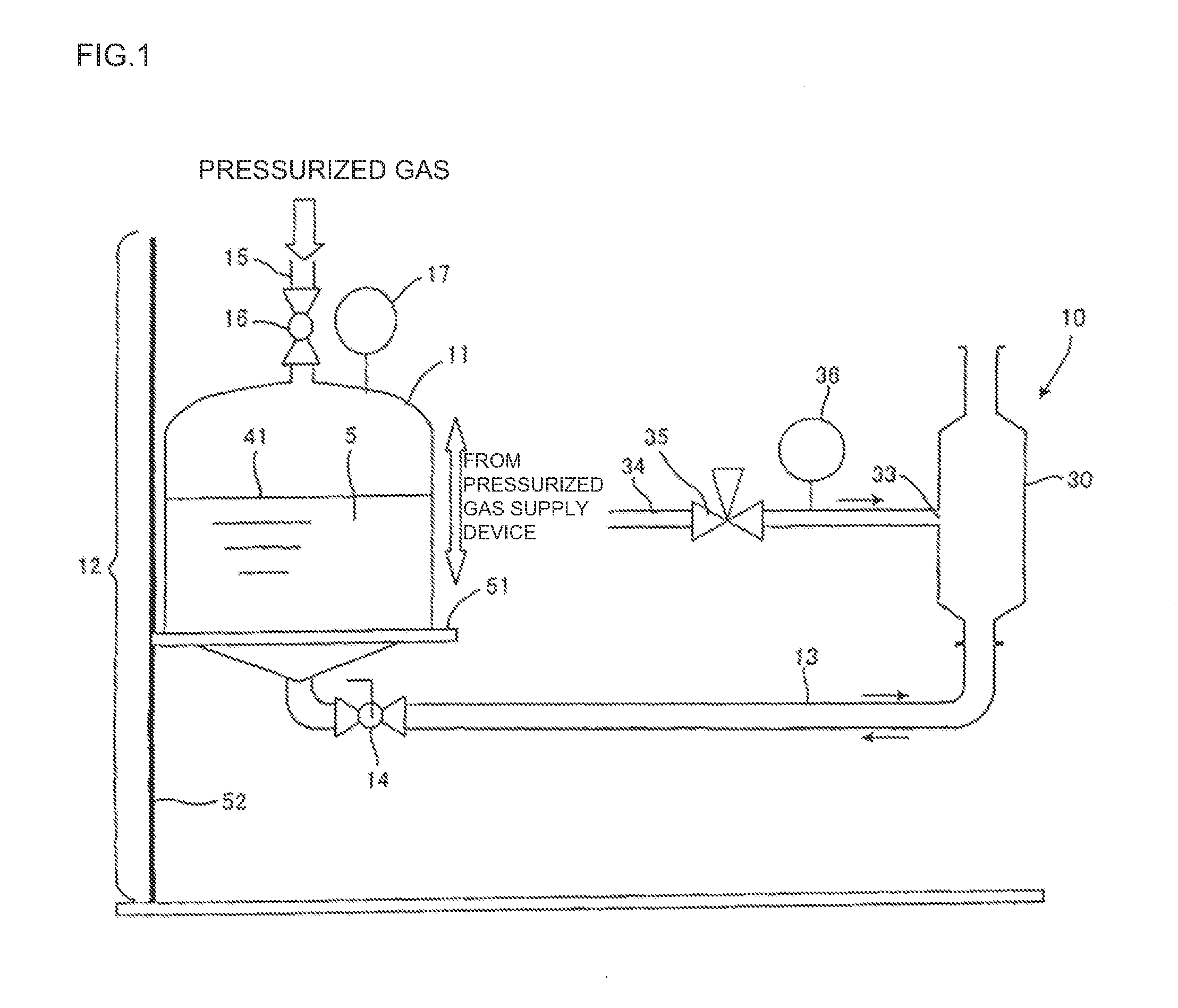Coat film forming method and coat film forming apparatus
a technology of forming method and forming apparatus, which is applied in the direction of membranes, vacuum evaporation coatings, coatings, etc., can solve the problems of difficult to secure a safety in the transfer task, and achieve the effect of shortening the operation time, easy execution and uniform thickness
- Summary
- Abstract
- Description
- Claims
- Application Information
AI Technical Summary
Benefits of technology
Problems solved by technology
Method used
Image
Examples
example 1
[0056]A porous body with a monolith form having a plurality of cells and with a column-shaped appearance (diameter of 180 mm and length of 1,000 mm, with glass-sealed end faces) was used as the object to be coated. The object to be coated 1 was set in the dipping tank 30 of the coating membrane forming apparatus 10 as shown in FIG. 1 with the sealing members (packing) 31 set as shown in FIG. 3 so that a coating membrane comprising a thermosetting polyimide resin precursor would be formed on the inner peripheral face of the cells. A solution of the thermosetting polyimide resin precursor was filled in the solution tank 11 with the valve 14 being closed. Then, the solution tank 11 was raised until its liquid level reached above the top end of the object to be coated 1 while supplying a pressurized gas into the solution tank 11 to pressurize inside of the solution tank 11.
[0057]Thereafter, the solution in the solution tank 11 was sent into the dipping tank 30 by opening the valve 14 wh...
example 2
[0059]A porous body with a monolith form having a plurality of cells and with a column-shaped appearance (diameter of 180 mm and length of 1,000 mm, with glass-sealed end faces) was used as the object to be coated. The object to be coated 1 was set in the dipping tank 30 of the coating membrane forming apparatus 20 as shown in FIG. 2 with the sealing materials (packing) 31 set as shown in FIG. 3 so that a coating membrane comprising a thermosetting polyimide resin precursor would be formed on the inner peripheral face of the cells.
[0060]Thereafter, as shown in FIG. 3, the thermosetting polyimide resin precursor solution filled in the solution tank 21 was sent into the dipping tank 30 by rotating the pump 24 (forward rotation) while supplying a pressurized gas into the space 32 formed by the inner peripheral face of the dipping tank 30, the outer peripheral face of the object to be coated 1, and the sealing members (packing) 31. The solution sent into the dipping tank 30 in the way a...
example 3
[0062]Fifteen porous bodies with tube forms (outer diameter of 10 mm and length of 1,000 mm) were used as the objects to be coated. These 15 tubular objects to be coated were set in the dipping tank 30 of the coating membrane forming apparatus 10 as shown in FIG. 1 with their opened area at the both ends being plugged with a masking material so that a coating membrane comprising a thermosetting polyimide resin precursor would be formed on their outer peripheral faces simultaneously. A solution of the thermosetting polyimide resin precursor was filled in the solution tank 11 with the valve 14 being closed. Then, the solution tank 11 was raised until its liquid level reached above the top end of the object to be coated while supplying a pressurized gas into the solution tank 11 to pressurize inside the solution tank 11.
[0063]Then, the valve 14 was opened to send the solution in the solution tank 11 into the dipping tank 30. The solution sent into the dipping tank 30 in the way as ment...
PUM
| Property | Measurement | Unit |
|---|---|---|
| contact time | aaaaa | aaaaa |
| pressure gauge | aaaaa | aaaaa |
| pressure | aaaaa | aaaaa |
Abstract
Description
Claims
Application Information
 Login to View More
Login to View More - R&D
- Intellectual Property
- Life Sciences
- Materials
- Tech Scout
- Unparalleled Data Quality
- Higher Quality Content
- 60% Fewer Hallucinations
Browse by: Latest US Patents, China's latest patents, Technical Efficacy Thesaurus, Application Domain, Technology Topic, Popular Technical Reports.
© 2025 PatSnap. All rights reserved.Legal|Privacy policy|Modern Slavery Act Transparency Statement|Sitemap|About US| Contact US: help@patsnap.com



